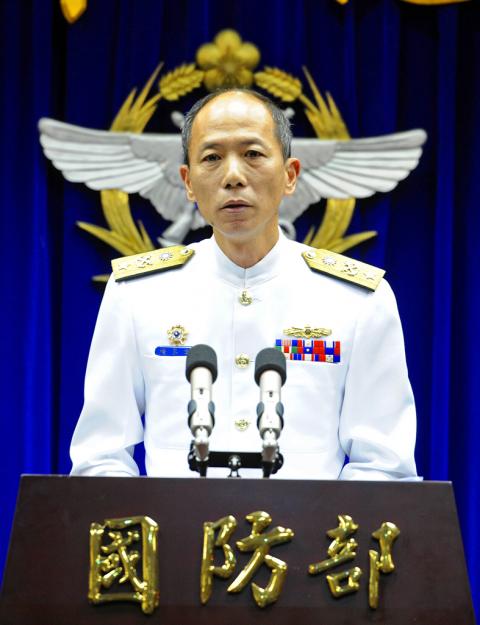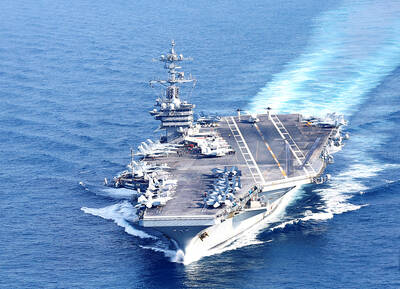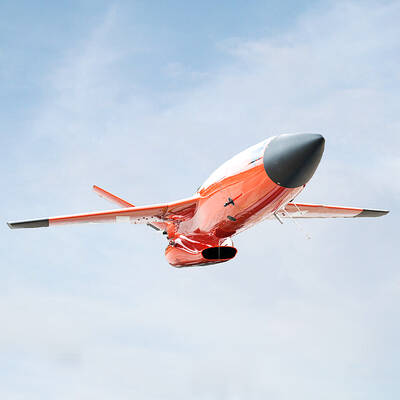The military is for the first time to incorporate cyberwarfare and civilian planes in its annual Han Kuang series of exercises later this month at various air bases and maritime areas.
The exercises will include drills centered on military personnel, equipment and aircraft to test joint combat capabilities of the air force, navy and army in case of an attack by China, Rear Admiral Mei Chia-shu (梅家樹) said.
As part of the exercise, the cyberwarfare drill is to test the military’s abilities to restore hobbled facilities, Mei said during a Ministry of National Defense press conference yesterday.

Photo: George Tsorng, Taipei Times
Live-fire drills will be held in waters off the eastern coast, south of Penghu, as well as in areas in Pingtung County, to test defensive capabilities, he said.
Exercises involving several civilian planes are to transport soldiers from Greater Kaohsiung to Penghu County to test readiness for wartime maneuvers, another military official said.
The Han Kuang exercises this year will last from Sept. 15 to Sept. 19 at designated sites, ministry spokesman Major General David Lo (羅紹和) said.
There will be drills to practice emergency takeoffs and landings for fighter jets on the Minsyong section of the Sun Yat-sen Freeway (Freeway No. 1), which passes through Chiayi County, said Major General Li Ting-sheng (李廷盛), director of the air force’s Combat Readiness Training Division.
Aircraft used in the drill this month will include F16-A/Bs, Mirage 2000-5s and Indigenous Defense Fighters (IDF), as well as the E-2K airborne early warning aircraft, a CH-47 helicopter, an OH-58D reconnaissance helicopter and two AH-1W Super Cobra attack helicopters, Li said.
The exercises this year are to simulate an attack from China that destroys Taiwan’s air force bases, leaving the military to rely on the freeway for emergency takeoffs and landings, he said.
It is also to test the military’s ability to conduct refueling and re-supply operations in times of war, Li added.
To conduct the drill, the section of the freeway between the Chiayi and Dalin exits will be closed for 11 hours beginning at midnight on Sept. 16.
Meanwhile, a new weapon, known as the “Wanjian missile” (萬劍彈), is reportedly ready for production after being developed for many years by the ministry.
Chinese Nationalist Party (KMT) Legislator Lin Yu-fang (林郁方) yesterday confirmed the news about the weapon, which is designed to destroy enemy runways.
Developed at a cost of about NT$3 billion (US$100 million), the Wanjian cruise missile system will go into production next year, after passing initial combat testing trials recently, Lin said.
The missile contains hundreds of cluster bomblets to maximize damage to runways, while it can also be used against other enemy targets, including harbors, military encampments, radar systems and missile launch installations.
“Our IDF jets have been configured to carry the Wanjian missiles and can reach targets within 300km. This has improved the air-to-land attack capability to greater than that of the F16-A/B jets and expanded the air force’s attack range for coastal military installations in China,” Lin said.
He added that 40 IDF jets were outfitted to carry Wanjian missiles by the end of last year, and eventually all the nation’s 127 IDF jets will be configured for such capability.
Additional reporting by CNA

CROSS-STRAIT COLLABORATION: The new KMT chairwoman expressed interest in meeting the Chinese president from the start, but she’ll have to pay to get in Beijing allegedly agreed to let Chinese Nationalist Party (KMT) Chairwoman Cheng Li-wun (鄭麗文) meet with Chinese President Xi Jinping (習近平) around the Lunar New Year holiday next year on three conditions, including that the KMT block Taiwan’s arms purchases, a source said yesterday. Cheng has expressed interest in meeting Xi since she won the KMT’s chairmanship election in October. A source, speaking on condition of anonymity, said a consensus on a meeting was allegedly reached after two KMT vice chairmen visited China’s Taiwan Affairs Office Director Song Tao (宋濤) in China last month. Beijing allegedly gave the KMT three conditions it had to

STAYING ALERT: China this week deployed its largest maritime show of force to date in the region, prompting concern in Taipei and Tokyo, which Beijing has brushed off Deterring conflict over Taiwan is a priority, the White House said in its National Security Strategy published yesterday, which also called on Japan and South Korea to increase their defense spending to help protect the first island chain. Taiwan is strategically positioned between Northeast and Southeast Asia, and provides direct access to the second island chain, with one-third of global shipping passing through the South China Sea, the report said. Given the implications for the US economy, along with Taiwan’s dominance in semiconductors, “deterring a conflict over Taiwan, ideally by preserving military overmatch, is a priority,” it said. However, the strategy also reiterated

‘BALANCE OF POWER’: Hegseth said that the US did not want to ‘strangle’ China, but to ensure that none of Washington’s allies would be vulnerable to military aggression Washington has no intention of changing the “status quo” in the Taiwan Strait, US Secretary of Defense Pete Hegseth said on Saturday, adding that one of the US military’s main priorities is to deter China “through strength, not through confrontation.” Speaking at the annual Reagan National Defense Forum in Simi Valley, California, Hegseth outlined the US Department of Defense’s priorities under US President Donald Trump. “First, defending the US homeland and our hemisphere. Second, deterring China through strength, not confrontation. Third, increased burden sharing for us, allies and partners. And fourth, supercharging the US defense industrial base,” he said. US-China relations under

The Chien Feng IV (勁蜂, Mighty Hornet) loitering munition is on track to enter flight tests next month in connection with potential adoption by Taiwanese and US armed forces, a government source said yesterday. The kamikaze drone, which boasts a range of 1,000km, debuted at the Taipei Aerospace and Defense Technology Exhibition in September, the official said on condition of anonymity. The Chungshan Institute of Science and Technology and US-based Kratos Defense jointly developed the platform by leveraging the engine and airframe of the latter’s MQM-178 Firejet target drone, they said. The uncrewed aerial vehicle is designed to utilize an artificial intelligence computer